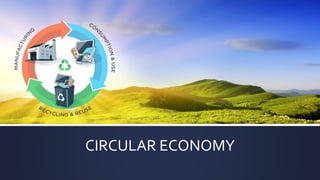
CIRCULAR ECONOMY.pptx
- 2. Introduction A circular economy is an economic system in which resources are used, reused, and recycled in a closed loop, minimizing waste and pollution. It aims to keep products, components, and materials at their highest utility and value at all times, in contrast to the traditional linear economy, which follows a "take, make, use, dispose" model.
- 3. History The concept of a circular economy was first introduced in the 1970s as a way to move away from the traditional linear economy, which is based on the "take, make, use, dispose" model.
- 4. Traditional Linear Economy In a linear economy, resources are extracted, used to create products, consumed, and then discarded as waste. This model is not sustainable in the long term, as it leads to the depletion of natural resources and the generation of waste and pollution.
- 6. The Circular Economy The circular economy, on the other hand, aims to keep resources in use for as long as possible and to minimize waste and pollution. It is based on the principles of designing out waste and pollution, keeping products and materials in use, and regenerating natural systems.
- 8. Goal The goal is to keep resources in use for as long as possible, extracting the maximum value from them before recovering and regenerating them. This is achieved through a combination of strategies such as product design for longevity and recyclability, product-as-a-service models, closed-loop production systems, and circular supply chains.
- 9. Benefits Circular economy has several benefits such as: • Reducing the use of virgin resources and reliance on finite resources • Decreasing the environmental impact of production and consumption • Creating new business opportunities and jobs • Improving resource efficiency and reducing costs • Providing a more sustainable and resilient economic system.
Editor's Notes
- May require more than one slide
- May require more than one slide
- May require more than one slide